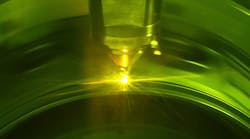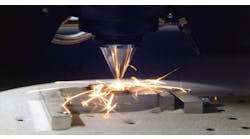Pratt & Whitney reports it has developed an additive manufacturing method for repair of critical components of its geared turbofan (GTF) engines, and contends that the new method will cut repair process times by over 60 percent. It added that it aims to industrialize the repair technique, and apply it throughout the network of more than 20 service centers and shops worldwide offering MRO for those engines.
"A more agile, additive repair process allows us to better serve our customers by improving turnaround time, while reducing tooling costs, complexity and set up," stated Kevin Kirkpatrick, vice president of Aftermarket Operations. "At the same time, it reduces our dependency on current material supply constraints.”
The new method was broadly described as “directed energy deposition,” the additive manufacturing (or 3D printing) technique that uses lasers or other focused heat sources to melt and deposit metal powder or wire onto a part to be repaired, or onto a build tray to form a new part.
The AM technique was developed at Pratt & Whitney's North American Technology Accelerator in Jupiter, Fla., in a collaborative effort with the Connecticut Center for Advanced Technology and the RTX Research Center.
Pratt & Whitney indicated it had used the new process to repair GTF structural case features, and future applications will be used to restore components worn through normal engine operation.
The GTF engine is Pratt & Whitney’s geared-turbofan engine, more than 2,200 of which have been delivered for installation on commercial aircraft for over 80 operators worldwide. Pratt & Whitney also holds orders for nearly 11,000 future GTF engines from over 90 customers.






